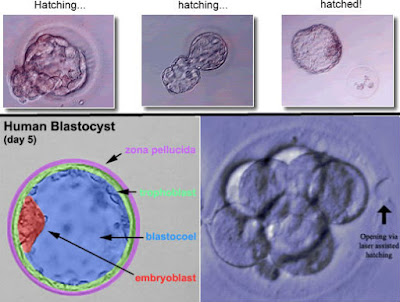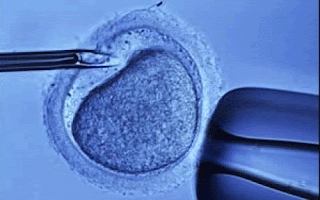Biology concepts – twinning, placenta, amnion, monozygotic, conjoined twins, in vitrofertilization
How can this be? Cloning humans is a highly technical affair, with all kinds of molecular biology and developmental biology knowledge required. It would require a team of scientists with a handful of PhD degrees ….. or …. a woman could just had monozygotic twins.
Twins come in two flavors – monozygotic and dizygotic. You may know them by other names. A zygote is a fertilized egg, so monozygotic twins come from one (mono) egg and dizygotic twins come from two separate fertilized eggs.
Monozygotic twins (MZ) are commonly called identical - they aren’t - but more on that later. Dizygotic twins are known as fraternal, but fraternal means brother, so this name is bad too.
You see a set of twins on the street. Do you think you would know if they are monozygotic or dizygotic? I bet you can’t.
You see a set of twins on the street. Do you think you would know if they are monozygotic or dizygotic? I bet you can’t.
For many years scientists were sure they could tell the difference by just looking; sure enough that they used the sight test to enter twins into studies on genetic traits. When DNA testing became more common, they found that many of the twins they studied were actually dizygotic. Science had to throw out forty years of twin research.
We’re going to talk about many exceptions amongst twins, but perhaps we should start with just what MZ twins are and aren’t, and how they might come about. First, there is an egg that is fertilized by a male gamete cell – a zygote is formed. The zygote splits two to three times over the first couple of days.
see this post). Inside the amnion inside the placenta is where the embryo develops into a fetus.
This how things normally happen, but about 3.5 times in 1000 live births, the zygote or embryo splits and becomes two embryos. This is possible because the cells of the early embryo are totipotent stem cells; they have the potential to become any type of human cell. Later on, the cells at different parts of the embryo are merely pluripotent– they can become several different types of cells. Even later, the cells begin to differentiate into the tissues that the fetus will need.
Therefore, those 3.5 embryos that split and become MZ twins have to split early in development. The placenta (part of the chorion) develops around day three, and most zygotes don’t split that early; therefore, 75% monozygotic twins are monochorionic(they share one placenta and chorion).
To become a dichorionicset of twins, the split must occur within those first two days, and this only occurs about 25% of the time. On the other hand, the amniotic sac develops around day nine. If the split occurs later than day nine, then the MZ twins will be monochorionic and monoamniotic(MoMo).
This is also rare because most splits occur before day nine. The result? – most MZ twins are monochorionic, diamniotic (MoDi). Can you explain why there can’t be a dichorionic monamniotic set of MZ twins? Of course you can.
By this time (8-14 days), the embryo is more than 15-30 cells total, called a blastocyst. It is hollow and the cells are just starting to assume roles, meaning they are no longer totipotent. So the split needs to come before the end of that second week. One theory is that the blastocyst collapses and the cells on each side of the pinch becomes an individual.
This is the traditional view of when MZ twins form and how to account for the placenta and anmniotic sac number. But there are other views. A newer theory contends that the split occurs much closer to fertilization, maybe in the first couple of divisions after fertilization. Under this hypothesis, the chorionicity and amnionicity have more to do with random fusion of separate structures rather than their development based on time of split. By the way – there’s no evidence for this yet, just some twins that may not fit the traditional pattern - if, in fact, the recorded timing was correct.
The question you shouldbe asking about MZ twins is just why the egg splits into two (and very rarely, three) in the first place. It’s rare, but it has happened throughout history, so there is a cause. Or causes.
The short answer is science doesn’t know yet, but it has many hypotheses. The rate of MZ twinning has been stable over the years and doesn’t show a predilection for a race or area of the world. These all point to MZ twinning having no genetic basis. So what might be causing it?
The increase in in vitro fertilization (IVF) therapies in the last decades has paralleled a slight increase in MZ twins. This isn’t because of more than one embryo implanted in IVF - those would be dizygotic twins, we’re talking an increase in MZ twins only here.
IVF therapies involve more than just implanting embryos. The reproductive system has to be made ready for the zygotes, and this means giving the lady lots of hormones. Might this throw off the balance and promote zygote splitting? Could be, but there are other possibilities.
The age of the embryo when implanted makes a difference. Five-six day embryos have a higher splitting rate than those that are implanted when they are only 2-3 days old. However, both age group embryos had a higher rate of MZ twinning than did control embryos from natural fertilizations. So perhaps we need to look further.
Each situation is accompanied by increased embryo splitting (weakened zona and delayed implantation in uterine wall) so perhaps its all zona regulated.
Then again, the idea that MZ aren’t linked to genetics may be wrong. There have been observations of MZ twins running through the males in some families, perhaps through a y-linked gene. Another study has documented seven families with higher than normal rates of MZ twinning.
It is through these mechanisms, or others we have no idea about yet, that an embryo might split to become MZ twins. But we have been assuming that the split embryo becomes two individuals. What if that doesn’t happen? What if the split embryos remain attached to one another? You get conjoined twins.
 |
Chang and Eng were the most famous of the Siamese twins. In fact, they are why we call conjoined twins Siamese. They became rich plantation owners in the American South, but lost all their money when the North won the Civil War. They were each married and had 21 children total. There are twins in the descendants (no conjoined), but neither Chang nor Eng had twin children themselves. |
There have been famous examples of conjoined twins, sometimes called Siamese twins because of the most famous pair – Chang and Eng of Siam in the 1800’s.
Conjoined twins can also be called imperfect twins, because the embryo split imperfectly. If the split occurs very late, perhaps after day 12 post-fertilization, the rate of conjoined twins might be increased. At this point the cells are already past the point of starting to differentiate, so they are becoming tissues and organs. The ones that split become organs on their own, but the cells that are shared will become organs and structures that the twins will share. In all, we don’t know the risk factors for creating conjoined twins, but it is interesting to note that Latin American women have a much higher rate of conjoined twins than anywhere else in the world. I can't imagine why.
Conjoined twins are described based on where they are joined. The majority are joined at the chest (called thoracopagus, pagos is from Greek = something joined) or the buttocks (pyopagus). The number and extent of organ and structure sharing can vary greatly, but thoracopagus twins often share a heart, while pyopagus twins might share a lower GI tract.
Needless to say, there are many more papers describing them and their problems than there are solutions and treatments. Surgery is getting better, but it depends on what they share. What we have described are the equally conjoined twins. But sometimes, one twin dominates over the other. One will be smaller, weaker, and less able to survive. This is called a parasitic twin. Taken to the extreme ……. Well, that will have to wait for next week.
For more information or classroom activities, see:
Monozygotic twins –
Zona pellucida –
Chorion and placenta –
Amnion –
Conjoined twins -





